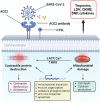The emerging role of heart-on-a-chip systems in delineating mechanisms of SARS-CoV-2-induced cardiac dysfunction
- PMID: 38818123
- PMCID: PMC11135153
- DOI: 10.1002/btm2.10581
The emerging role of heart-on-a-chip systems in delineating mechanisms of SARS-CoV-2-induced cardiac dysfunction
Abstract
Coronavirus disease 2019 (COVID-19) has been a major global health concern since its emergence in 2019, with over 680 million confirmed cases as of April 2023. While COVID-19 has been strongly associated with the development of cardiovascular complications, the specific mechanisms by which viral infection induces myocardial dysfunction remain largely controversial as studies have shown that the severe acute respiratory syndrome coronavirus-2 can lead to heart failure both directly, by causing damage to the heart cells, and indirectly, by triggering an inflammatory response throughout the body. In this review, we summarize the current understanding of potential mechanisms that drive heart failure based on in vitro studies. We also discuss the significance of three-dimensional heart-on-a-chip technology in the context of the current and future pandemics.
Keywords: discovery and development; drug; organoids and organ‐mimetic systems; tissue engineering.
© 2023 The Authors. Bioengineering & Translational Medicine published by Wiley Periodicals LLC on behalf of American Institute of Chemical Engineers.
Conflict of interest statement
M.R. and Y.Z. are inventors on a patent describing Biowire II heart‐on‐a‐chip technology that is licensed to Valo Health. They receive royalty payments. The remaining author declares no conflicts of interest.
Figures






Similar articles
-
Infiltrating monocytes drive cardiac dysfunction in a cardiomyocyte-restricted mouse model of SARS-CoV-2 infection.J Virol. 2024 Sep 17;98(9):e0117924. doi: 10.1128/jvi.01179-24. Epub 2024 Aug 29. J Virol. 2024. PMID: 39207134 Free PMC article.
-
Myocardial injury and COVID-19: Possible mechanisms.Life Sci. 2020 Jul 15;253:117723. doi: 10.1016/j.lfs.2020.117723. Epub 2020 Apr 28. Life Sci. 2020. PMID: 32360126 Free PMC article. Review.
-
Pathogenic mechanisms of cardiovascular damage in COVID-19.Mol Med. 2024 Jun 19;30(1):92. doi: 10.1186/s10020-024-00855-2. Mol Med. 2024. PMID: 38898389 Free PMC article. Review.
-
Long COVID-19 and the Heart: Is Cardiac Mitochondria the Missing Link?Antioxid Redox Signal. 2023 Mar;38(7-9):599-618. doi: 10.1089/ars.2022.0126. Epub 2022 Dec 28. Antioxid Redox Signal. 2023. PMID: 36053670 Free PMC article. Review.
-
Cardiovascular impact of COVID-19 with a focus on children: A systematic review.World J Clin Cases. 2020 Nov 6;8(21):5250-5283. doi: 10.12998/wjcc.v8.i21.5250. World J Clin Cases. 2020. PMID: 33269260 Free PMC article.
Cited by
-
Advances in cardiac organoid research: implications for cardiovascular disease treatment.Cardiovasc Diabetol. 2025 Jan 18;24(1):25. doi: 10.1186/s12933-025-02598-8. Cardiovasc Diabetol. 2025. PMID: 39827092 Free PMC article. Review.
References
-
- Oude Munnink BB, Nieuwenhuijse DF, Stein M, et al. Rapid SARS‐CoV‐2 whole‐genome sequencing and analysis for informed public health decision‐making in The Netherlands. Nat Med. 2020;26:1405‐1410. - PubMed
Publication types
Grants and funding
LinkOut - more resources
Full Text Sources
Miscellaneous

